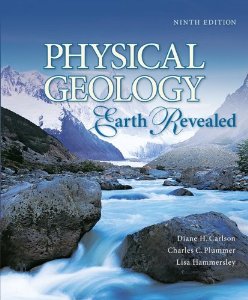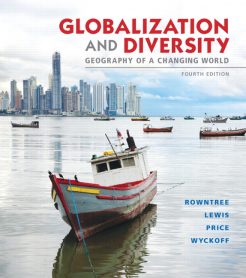Description
***THIS IS NOT THE ACTUAL BOOK. YOU ARE BUYING the Test Bank in e-version of the following book***
Title: Test Bank for Physical Geology Earth Revealed 9th Edition Diane Carlson Download
Edition: 9th Edition
ISBN-10: 0073369403
ISBN-13: 978-0073369402
– The test bank is what most professors use an a reference when making exams for their students, which means there’s a very high chance that you will see a very similar, if not exact the exact, question in the test!
– The file is either in pdf, doc, rtf or zipped in the package and can easily be read on PCs and Macs.
– Delivery is INSTANT. You can download the files IMMEDIATELY once payment is done.
We also faced similar difficulities when we were students, and we understand how you feel.
But now, with the Test Bank for Physical Geology Earth Revealed 9th Edition Diane Carlson Download, you will be able to
* Anticipate the type of the questions that will appear in your exam.
* Reduces the hassle and stress of your student life.
* Improve your studying and also get a better grade!
* Get prepared for examination questions.
* Can save you time and help you understand the material.
This is the quality of service we are providing and we hope to be your helper.
Delivery is in the next moment. Test Bank is accurate.
If you have any questions, or would like a receive a sample chapter before your purchase, please contact us at inquiry@testbankcorp.com
Chapter 03
The Sea Floor
True / False Questions
- The deepest places on Earth, more than 11 km below sea level, are the abyssal plains.
FALSE
- Terrigineous sediment is sediment derived from the land.
TRUE
- Ocean water originated mainly from degassing of the Earth’s interior.
TRUE
- All rocks and sediments of the sea floor are more than 3 billion years old.
FALSE
- The ocean became salty as water picked up chlorine from volcanic gases and sodium and magnesium from weathering of minerals at the Earth’s surface.
TRUE
- Ophiolitic sediment is composed of wind-blown dust and microscopic skeletons that settle slowly to the sea floor.
FALSE
- Guyots and seamounts are scattered randomly on the sea floor.
FALSE
- The continental rise is a wedge of sediment that extends from the lower part of the continent slope to the deep-sea floor.
TRUE
- Submarine canyons are erosional features.
TRUE
- An oceanic trench is a deep narrow rift parallel to the crest of a mid-oceanic ridge.
FALSE
- Abyssal plains are the flattest features on Earth.
TRUE
- Most seamounts are active volcanoes.
FALSE
- Atolls are circles of reefs that rim lagoons.
TRUE
- A rift valley runs down the crest of most mid-oceanic ridges.
TRUE
- Pelagic sediment is sediment that settles slowly through the ocean water.
FALSE
- Passive margins are found on the edges of most of the landmasses bordering the Pacific Ocean.
FALSE
- Oceans cover more than 71% of the Earth’s surface.
TRUE
- The island of Iceland appears to be an exposed section of the Atlantic mid-oceanic ridge.
TRUE
- A contour current is a bottom current that flows parallel to the slopes of the continental margin.
TRUE
- Continental slopes are often marked by lines of hot springs that precipitate metals.
FALSE
Multiple Choice Questions
- The study of _____ rocks, sediment, and topography provided most of the information that led to the concept of plate tectonics.
A.seafloor
B. ocean boundaries containing
C. continental interior
D. mid-oceanic ridge
E. abyssal plains
- These machines can take geologists to many parts of the sea floor to observe, photograph, and sample rock and sediment.
A.deep sea drilling platforms
B. submersibles
C. sonar
D. echo sounder
E. multibeam sonar
- This instrument works on essentially the same principles as echo sounder but can penetrate the bottom of the sea floor and provides more information.
A.multibeam sonar
B. single beam sonar
C. seismic refraction profiler
D. seismic reflection profiler
E. sonar profiler
- Abyssal fans are made up of _____ sediment that has moved down submarine canyons
A.abyssal
B. continental slope
C. deep sea
D. marine pelagic
E. land-derived
- Turbidity currents are great masses of sediment-laden water that are pulled downhill by ____.
A.landslides
B. submarine canyons
C. gravity
D. earthquakes, storms, volcanic eruptions
E. Earth’s rotation
- _____ currents are bottom currents that flows parallel to the slopes of the continental margin.
A.Turbidity
B. Gulf Stream
C. Newfoundland
D. Contour
E. Abyssal
- A(n) _____ continental margin usually lacks a continental rise and an abyssal plain and is associated with convergent plate boundaries.
A.active
B. passive
C. transform
D. subducting
E. remote
- Earthquakes, volcanoes, Benioff seismic zones, and island arcs are all associated with this sea floor feature.
A.guyots
B. passive margin
C. seamounts
D. oceanic trench
E. abyssal plains
- Mid-oceanic ridges are often marked by lines of _____ that carry and precipitate metals.
A.ocean currents
B. hot springs
C. seismic ridges
D. submarine volcanoes
E. ocean trenches
- _____ are major lines of weakness in Earth’s crust that cross the mid-oceanic ridge at right angles.
A.Abyssal fans
B. Fracture zones
C. Submarine canyons
D. Transform faults
E. Fold belts
- Geologists’ ideas about the composition of ocean crust are greatly influenced by the study of ____.
A.ophiolites
B. continental volcanoes
C. chert
D. the Mohorovicic discontinuity
E. the asthenosphere
- The ____ is a shallow submarine platform at the edge of a continent.
A.abyssal plain
B. continental shelf
C. aseismic ridge
D. rise
E. trench
- A(n) _____ is a great mass of sediment-laden water that is pulled downward by gravity along the continental slope.
A.avalanche
B. underwater landslide
C. turbidity flow
D. mudflow
E. gravity slide
- Turbidity currents flow down the continental slope until they come to rest on ___.
A.the continental shelf
B. the mid-oceanic ridge
C. a guyot
D. the abyssal plain
E. a submarine trench
- Shallow focus earthquakes on the sea floor are associated with ___.
A.trenches
B. abyssal rises
C. guyots
D. abyssal plains
E. mid-ocean ridge crests
- The _____ crust of the sea floor is covered in many places with layers of sediment.
A.basalt
B. granite
C. rhyolite
D. serpentine
E. andesite
- Most geologists think that the flat summits of seamounts ___.
A.are uplifted sea floor
B. were eroded flat by wave action
C. are fault surfaces
D. are remnants of the continental shelf
E. are remnants of plateau basalts
- The crests of mid-oceanic ridges are associated with ____.
A.pelagic sediments
B. barrier reefs
C. rift valleys
D. abyssal plains
E. Benioff zones
- A basic tool for indirectly studying the sea floor is the ____, which measures water depth.
A.drilling ship
B. rock dredge
C. submersible
D. echo sounder
E. gravimeter
- Water depth increases over a continental shelf to the outer edge depth of _____ to ____ meters.
A.500; 600
B. 400; 500
C. 300; 400
D. 200; 300
E. 100; 200
- Seismic surveys of the sea have shown the oceanic crust to be divided into _______ major layers.
A.3
B. 6
C. 5
D. 2
E. 7
- Many guyots and seamounts are aligned in chains (for example the Hawaiian Islands and Emperor seamounts) that form major _____.
A.trench systems
B. aseismic ridges
C. Benioff zones
D. mid-ocean ridges
E. continental rises
- _____ are rounded masses of rock that form when molten lava erupts into cold water.
A.Gabbro mountains
B. Sheeted dikes
C. Pillow lava
D. Dunite dikes
E. Columnar basalts
- A ______ is a bottom flowing current that flows parallel to the slopes of the continental margins.
A.density flow
B. surface current
C. turbidity current
D. contour current
E. coriolis current
- _______ is an island on a mid-oceanic ridge.
A.Madagascar
B. Japan
C. Cuba
D. Hawaii
E. Iceland
- Most seamounts are ______.
A.extinct volcanoes
B. granitic intrusions
C. submerged reefs
D. fault block grabens
E. ophiolites
- Project FAMOUS used submersibles to study ______.
A.trenches
B. mid-ocean ridges
C. guyots
D. reefs
E. continental rises
- In a passive continental margin, there is a lack of _______.
A.seamounts
B. guyots
C. earthquakes, volcanoes, and young mountain belts
D. no riverine discharge
E. sediments
- The abyssal plains are formed of _____.
A.sediment from meteoric dust
B. pillow basalts
C. mid-oceanic ridges
D. horizontal layers of sediment
E. volcanic ash
- Oceanic trenches are marked by _______.
A.no seismicity
B. shallow depths
C. positive gravity anomalies
D. high heat flow
E. low heat flow
- Oceans cover _____ percent of the Earth’s surface.
A.70
B. 90
C. 80
D. 60
E. 50
- Thick deposits of sediment called _____ are found at the base of many submarine canyons.
A.abyssal fans
B. continental rises
C. continental slopes
D. continental shelves
E. guyots
- The Grand Banks cable breaks of 1929 are interpreted to be the result of earthquake-caused ____.
A.earthquakes
B. contour currents
C. tsunamis
D. underwater volcanic eruptions
E. turbidity currents
- The continental rise typically ends at a(n) _______ at a depth of about 5 kilometers.
A.slope
B. trench
C. abyssal plain
D. mid-oceanic ridge
E. continental slope
- The continental shelves of the world are typically covered by relatively young sediments derived from ___________.
A.contour currents
B. mid-oceanic ridges
C. turbidity currents
D. land
E. continental shelves
- _____ are V-shaped valleys that run across continental shelves and down continental slopes.
A.Rift valleys
B. Submarine canyons
C. Submarine trenches
D. Guyots
E. Fracture zones
- __________ is the name applied to hot springs on the seafloor where 350 degree Celsius metal-rich solutions are discharged into the cold waters of the ocean.
A.Black smokers
B. Fumaroles
C. Ophiolites
D. Andesite
E. Hot spots
- The continental shelf is part of the ____.
A.abyssal plain
B. continents
C. mid-oceanic ridge
D. island arc system
E. true ocean basin
- ______ proposed that the three types of coral reefs are related to each other by subsidence of a central volcanic island.
A.Isaac Newton
B. Charles Plummer
C. George Bush
D. Charles Darwin
E. Diane Carlson
- _____ parallel the shore, but are separated from it by wide, deep lagoons.
A.Barrier reefs
B. Atolls
C. Patch reefs
D. Guyot reefs
E. Fringing reefs







Reviews
There are no reviews yet.